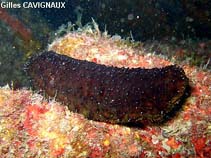Holothuria forskali Chiaje, 1823
Black sea cucumber| Native range | All suitable habitat | Point map | Year 2050 |

|
| This map was computer-generated and has not yet been reviewed. |
| Holothuria forskali AquaMaps Data sources: GBIF OBIS |
Classification / Names Common names | Synonyms | CoL | ITIS | WoRMS
Holothuroidea | Holothuriida | Holothuriidae
Environment: milieu / climate zone / depth range / distribution range Ecology
Benthic; depth range 1 - 125 m (Ref. 85345). Subtropical
Distribution Countries | FAO areas | Ecosystems | Occurrences | Introductions
Atlantic and the Mediterranean Sea.
Length at first maturity / Size / Weight / Age
Maturity: Lm ? range ? - ? cm Max length : 25.0 cm TL male/unsexed; (Ref. 358)
Short description Morphology
Maximum size: 25 cm. Body: with more or less round cross section; ventral face with 3 lines with parapodes with suction cup. Tegument: more fragile constellated with multiple papillae. Color: Brown; papillae, in a variable number, being of beige or white color, at always brown end. The animal is equipped with tubes of Vat which it expels with the least stimulus (Ref. 358).
Maximum size: 25 cm. Species presents at all depths. In the event of stimulus by contact, defends itself by expelling its tubes of Vat. Very adherent, they discourage frequently inclinations of the possible attackers or predatory. When the stimulus persist, the animal can go until excreting the whole of its digestive tract. The tubes of Vat and the bodies assigned to digestion are regenerated in the span of a few weeks if the conditions are favorable (Ref. 358). habitat: Hard funds of primary education types and secondary, more rarely in herbarium; very commune in the Mediterranean basin. Nourishes various organic fragments, (charging) literally the elements of the ground in its oral opening; located at the back of the body, using its tentacles oral of flattened form. The animal sorts and introduces the edible organic substances, and rejects the elements not metabolized, particularly sand, in the form of lengthened excrements (Ref. 358).
Life cycle and mating behavior Maturity | Reproduction | Spawning | Eggs | Fecundity | Larvae
Members of the class Holothuroidea are gonochoric and have only one gonad. Spawning and fertilization are both external and some exhibit brooding. Life cycle: Embryos develop into planktotrophic larvae (auricularia) then into doliolaria (barrel-shaped stage) which later metamorphose into juvenile sea cucumbers.
Main reference
References | Coordinator | Collaborators
Göthel, H. 1992. (Ref. 358)
IUCN Red List Status (Ref. 130435)
Least Concern (LC) ; Date assessed: 20 May 2010
CITES status (Ref. 108899)
Not Evaluated
CMS (Ref. 116361)
Not Evaluated
Threat to humans
Human uses
| FishSource |
Tools
More information
Internet sources
BHL | BOLD Systems | CISTI | DiscoverLife | FAO(Publication : search) | Fishipedia | GenBank (genome, nucleotide) | GloBI | Gomexsi | Google Books | Google Scholar | Google | PubMed | Tree of Life | Wikipedia (Go, Search) | Zoological Record
Estimates based on models
Preferred temperature
(Ref. 115969): 14.1 - 21, mean 17.9 (based on 180 cells).
Price category
(Ref. 80766):
Unknown.



